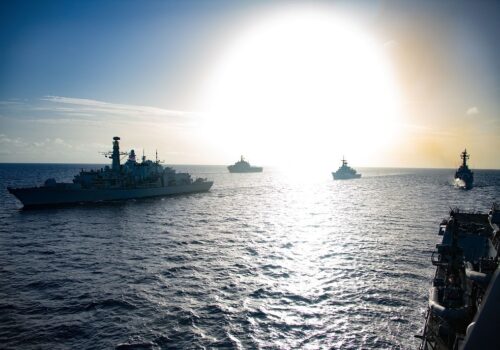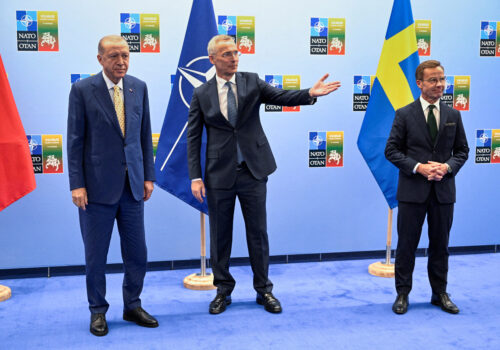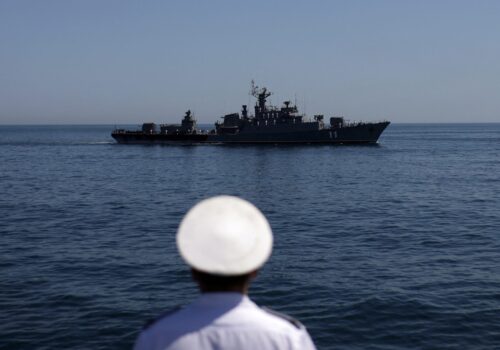Four NATO defense priorities for the upcoming Washington summit
At its seventy-fifth anniversary summit in July, NATO must ensure that it is as fit for the future as it has been for the past decades in its purpose of enhancing deterrence and assuring collective defense. Accomplishing that goal, however, will require the Alliance to transform its approach to defense by focusing on four priorities: 1) incorporating new technologies into military capabilities, 2) engaging new defenders beyond the traditional state-centric military model, 3) increasing its capacity for multidomain operations, and 4) adding new resources to support these changes.
The threat that Russia presents to NATO members is the most immediate reason these transformations are needed. As its war on Ukraine continues, Russia is enhancing its military capabilities. Russian defense spending is reportedly climbing to 6 percent of gross domestic product (GDP) this year, and Russian defense industries are significantly expanding. That expanded effort could allow Russia to reconstitute its ground forces as early as three to five years after the conclusion of its war in Ukraine, according to estimates cited in a recent New York Times article. When added to its substantial air, naval, cyber, and space capabilities, it would make Russia a formidable military in the relative near to medium term. Moreover, in the event of a conflict with NATO, Russia likely would receive significant support from China, Iran, and North Korea. After all, Moscow is already relying on economic and technological support arising from its “no limits” relationship with Beijing. Comparably, Tehran and Pyongyang have provided ammunition and armaments to Russia for use against Ukraine, and they could be expected to provide similar support in the event of a Russia-NATO conflict. In short, NATO allies are facing a consequential military adversary in Russia, most probably for the long term.
Nonetheless, NATO can maintain deterrence and effective defense by undertaking four transformational approaches to guide the Alliance going forward.
Embrace the technological revolution
First, NATO needs to incorporate the key elements of the ongoing technological revolution as exemplified by unmanned vehicles, additive manufacturing, low-Earth-orbit satellites, and artificial intelligence. Russia’s war on Ukraine has shown the significant battlefield effects that such technologies have had. For example, unmanned aerial vehicles have been used extensively in Ukraine for intelligence collection, as attack forces and supporting capabilities, and even as explosive shells in lieu of artillery. Unmanned maritime vehicles have damaged or destroyed both naval infrastructure and ships. Additive manufacturing has provided manufacturing capabilities and logistic support for artillery, especially critical parts. Low-Earth-orbit satellites, complemented by artificial intelligence, have provided targeting information, intelligence, surveillance, reconnaissance, and key imagery, among other uses.
NATO needs to incorporate these key elements of the new technological revolution across its defense architecture, from capability development to acquisition to operations. The United States is taking important steps on unmanned vehicles through the Replicator initiative and in space through reliance on commercial companies for launch, sensing, and communications capabilities as a rapid way to offset adversary advantages, but the Alliance as a whole needs to adopt these new approaches. At the research and development end of the spectrum, NATO’s Defense Innovation Accelerator for the North Atlantic could represent an important intra-Allied platform to identify, invest in, and eventually scale up critical emerging technologies.
As an important step in capitalizing on the technological revolution in NATO’s operations, the Alliance needs to adopt doctrinal and strategic guidance at the Washington summit for the acquisition and utilization of advanced technologies. Most critically, the summit should ensure that requirements for new technologies are included in the new NATO Defense Planning Process (NDPP) capability targets starting later this year. For example, the NDPP will need to define allied capability targets for space, including intelligence, surveillance, and reconnaissance; communications; and counter-space. Such targets can likewise guide NATO’s new Defense Production Action Plan.
Incorporate private-sector defense approaches
Second, NATO needs to establish a systemic approach for incorporating new defenders as part of its operational capabilities by complementing the traditional state-driven military model with private sector and individual-led approaches.
NATO needs to prioritize the engagement of the private sector for critical operational activities in wartime. Such private sector efforts are a “sixth domain” (complementary to the five warfare domains of air, land, naval, cyber, and space), with especial focus on the key areas of critical infrastructure resilience and assured wartime communications. NATO nations need to establish contractual arrangements with high-end cybersecurity providers to protect the critical infrastructures necessary for wartime effectiveness, including air, rail, ports, the electric grid, and pipelines. Comparable arrangements with communications companies, and especially companies operating low-Earth-orbit satellites, should also be established. Such arrangements should include the training and exercises necessary for effective resilience in wartime with the costs required included in national defense or security budgets.
NATO nations also need to enhance their own military cyber capabilities. In particular, NATO nations each need to establish a capacity to surge the number of cybersecurity personnel available in wartime. This could be done through the creation of national cybersecurity civilian reserve corps and/or the expansion of military reserve cybersecurity capabilities. For these personnel, nations should focus—as the United Kingdom has done—on an individual’s cyber capabilities and should not require the same physical capacities that are ordinarily required of military personnel. Additionally, US Cyber Command’s “hunt forward” model of operations—which provides defensive capabilities to nations with less cybersecurity expertise—should be expanded in wartime to provide continuous support to key critical infrastructure throughout the Alliance (as well as in the United States). Nations besides the United States with expert cyber capabilities such as France, Estonia, and the United Kingdom can undertake such hunt forward activities along with the United States, an initiative which could also become an important intra-allied capacity-building effort.
The communications and energy sectors of NATO nations depend in significant part on undersea cables and pipelines which are highly vulnerable to attack. Recognizing this issue, NATO has already established the NATO Maritime Centre for the Security of Critical Undersea Infrastructure. However, that organization is essentially only an information sharing entity. NATO needs to go beyond information sharing and should work with nations to establish an international undersea infrastructure protection corps that would combine governmental and private activities to support operations which provide resilient protection, including repair and reconstitution of undersea cables and pipelines. This group could initially include the United States, United Kingdom, France, and Norway—all nations with existing undersea maritime capabilities—as well as key private-sector cable and pipeline companies.
Focus on multidomain operations
Third, NATO needs to revise its warfighting approach to focus on multidomain operations. This will require combining high-end capabilities with low-cost but still highly effective technologies. At the high-cost end, NATO allies, in addition to the United States, are acquiring more than five hundred F-35 aircraft which will provide key elements of communications and targeting networks for multidomain operations in addition to their stealth capabilities for attack missions such as suppression of enemy air defenses.
In the low-cost arena, the NATO Summit should task the military authorities with establishing multidomain task forces. This initiative would build on the efforts currently being undertaken by the United States including the existing US Army multidomain task force, which is operational in Europe. Such task forces can provide a framework for such capabilities as low-cost multidomain surveillance and sensor-shooter networks; dynamic logistics and sustainment, including the use of artificial intelligence to ensure logistical effectiveness during high-intensity conflict; and integrated cyber and kinetic offense, focused against adversary logistics and war-supporting infrastructures. Importantly, such capabilities can be adopted throughout the force in the near and medium term.
Increase defense spending—and efficiency
Fourth, NATO needs the right resources to enable its defense and deterrence transformation. Spending more is important, and burden-sharing will be a key topic at the Washington summit. Even as in 2023 only eleven out of thirty-one NATO member states were meeting the Alliance’s 2 percent of GDP spending target, the summit should increase that goal and agree on a 2.5 percent target. This would be an important signal politically that NATO is serious about defense and would provide a unifying internal target for allies. Additionally, allies should consider ways to strategically pool resources where beneficial. For example, the NATO communiqué should support the creation of a European Union security and defense budget focused on mobility, sustainment, and critical-infrastructure resilience.
Spending efficiently is just as important as spending more. To maximize the results of national spending, NATO should organize multinational consortiums to develop and acquire key capabilities under the aegis of the NATO Support and Procurement Agency. One example of such a consortium would be investments in the low-cost unmanned vehicles that have demonstrated consequential battlefield effects in Ukraine. It will be important for Europe’s rearmament efforts to include enablers such as intelligence, surveillance and reconnaissance, air and missile defense, and electronic warfare capabilities in these investments, and to balance high-end capabilities such as F-35s with lower-cost but critical assets such as plain old artillery shells.
The upcoming NATO Summit in Washington, DC, offers an opportunity for the Alliance to prioritize new and transformational capabilities. With them, NATO can continue to provide deterrence and defense for its member state populations (now more than one billion people) into the future, just as it has done for the past seventy-five years.
Franklin D. Kramer is a distinguished fellow and board member at the Atlantic Council and a former assistant secretary of defense for international security affairs.
Anca Agachi is a nonresident fellow at the Transatlantic Security Initiative of the Atlantic Council’s Scowcroft Center for Strategy and Security and is currently serving as a (defense) policy analyst at RAND.
The views, opinions, findings, conclusions, and recommendations contained herein are the authors’ alone and not those of the Atlantic Council or RAND or its research sponsors, clients, or grantors.
Further reading
Thu, Feb 1, 2024
NATO should be ambitious with its new Southern Flank Strategy
New Atlanticist By Jason Davidson
In July, the Alliance is scheduled to adopt its first ever Southern Flank Strategy in Washington. The bolder it is, the better.
Tue, Jan 23, 2024
Experts react: How close is Sweden to joining NATO after the Turkish parliament’s approval?
New Atlanticist By
The ratification now goes to Turkish President Recep Tayyip Erdoğan to sign, after which all allies will have approved Sweden’s membership except Hungary. Atlantic Council experts explain more.
Wed, Jan 10, 2024
To fend off Russia in the Black Sea, the US and NATO need to help boost Allies’ naval power
New Atlanticist By Gavin Clough
The absence of a credible and sustained allied naval presence across the Black Sea opens the door for Russia to disrupt commercial shipping in international waters.
Image: NATO Secretary General Jens Stoltenberg speaks to the media during a NATO Defence Ministers' meeting at the Alliance's headquarters in Brussels, Belgium October 12, 2023. REUTERS/Johanna Geron


